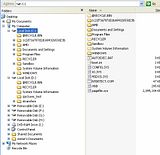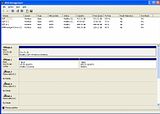Where did you read this? As far as I can tell dual booting is maybe not extremely common but it is definitely possible and safe and many people do it without any problems.
I have also successfully dual booted XP and 7 for a very long time without any problems at all and I am now dual booting 7 and 7 without any problems (besides for the system restore).
I told you where I read that -
http://www.sevenforums.com/
I have made several hundred postings there over several years and do not have the time to locate the relevant topic in which my questions were answered.
I just remember the advice that I have followed and also suggest.
I KNOW that dual booting SHOULD be safe, but experts who have understanding of how to consistently avoid problems do NOT allow the "alternative" partition to be needlessly accessible to the "running Windows system" via a drive letter.
I am absolutely confident that your alternative Windows "system restore points" are needlessly accessed via the letter D:\
If you delete anything within "D:\Windows\SYSTEM32\"
(either by accident or just to prove me wrong - and confirm that it is deleted)
You will find that either you cannot boot into that alternative Windows system, or if you can then whatever you deleted is likely to remain absent.
Having that drive letter allows damage to the contents of that partition as a result of
User accidents when doing the wrong things ;
Running third party maintenance utilities
(possibly including CCleaner and Defraggler, and certainly including alternative tools that do not confine their actions to Microsoft approved API's);
Windows natural errors and accidents ;
Easy infections of the alternative quiescent system from malware entering the running system.
I guess that they are both using the same system partition so the system restore points for both are stored in the same place?
Wrong ![:(]()
I predict that when booted into the alternative system it was probably C:\ -
and absolutely certainly its properties would have shown
A System Volume Name of "Second Disk"
and a Capacity of 465 GB and Free Space 423 GB.
I suggest you double check.
Your screen snapshot tells me that :-
You "normally" booted into Windows
on a partition shown as "(C:)"
and it has a Capacity of 931 GB and Free Space 842 GB
and that Windows Explorer CAN ALSO SEE your alternative Windows System as being
on a partition shown as "Second Disk (D:)"
and it has a Capacity of 465 GB and Free Space 423 GB
and Windows Explorer can see :-
both operating systems located at
C:\Windows\ and D:\Windows\
and if you are an administrator and can view hidden system files,folders and drives then
Windows Explorer can also see :-
C:\System Volume Information\ and D:\System Volume Information\
and consequently even if you are not an administrator and cannot view hidden system files,folders and drives,
because you have run and therefore authorised CCleaner,
it WILL access and possibly modify the restore points which are held in
C:\System Volume Information\ and D:\System Volume Information\
I could be wrong, but I predict that if you use Windows Disk Management to remove the drive letter D:\,
then CCleaner should no longer see the restore points of the other system.
Your screen snapshot ALSO tells me that when you boot into the alternative Windows System :-
You have "alternatively" booted into Windows
on a partition shown as "Second Disk (C:)" - (assuming a typical installation )
and with a Capacity of 465 GB and Free Space 423 GB
and that your "normally booted" Windows system would have been found on
a partition shown as "(? :)" - probably "(D:)" but could be anything or nothing
and a Capacity of 931 GB and Free Space 842 GB
Please note that System Volume Names are defined on the physical drives and are the same regardless of the operating system that sees them.
Drive Letters are only know by the operating system which is running,
and you can use one system to change the drive letters but this has no effect upon the letters assigned by the alternative system.
Regards
Alan




